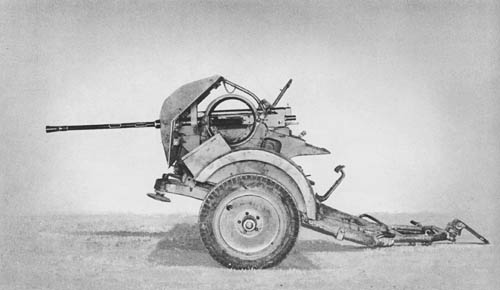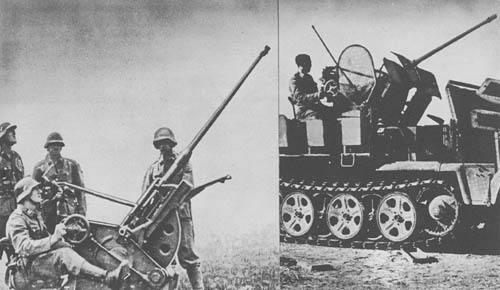
The Flak 38 was introduced in 1940 to replace the 2 cm Flak 30. Its performance does not differ materially from that of the earlier weapon, except for a higher cyclic rate of fire of 450 rounds per minute.
The gun is operated by short barrel recoil and the residual pressure of gas in the barrel. Recoil unlocks the breech and imparts rearward acceleration to the breechblock carrier. This rearward acceleration is assisted by gas pressure after unlocking has been completed so that the breechblock travels back with sufficient force to perform the operations of extraction, ejection, and compression of the return spring.
The energy required for closing the breech and carrying a fresh round to the chamber is provided by the return spring, assisted at first by the buffer spring.
The breechblock is of the Solothurn type. Any tendency toward rebound is counteracted by the impact of an inertia block at the end of the forward movement. The barrel has resistance rings which brake the recoil and forward movements of the barrel; a buffer and buffer spring arrest the backward movement of the breech block.
This weapon may be adjusted for either semi-automatic or full-automatic fire. It is fired by a foot pedal. Cartridges are fed from a 20-round curved box magazine hinged on the left of the gun.
The mounting consists principally of the base, cradle, traversing and elevating gears, firing mechanism, and lighting equipment.
Traverse is 10° per turn of handwheel in fine gear and 30° in coarse gear; rate of elevation or depression is 4° per turn in fine gear and 12° in coarse gear.
The weapon, which is transported on a trailer, may be mounted on railways cars or road vehicles. When traveling over difficult country, gun and mounting may be split into six loads.
SPECIFICATIONS
| Caliber | 20 mm (.79 in.) | |
| Length of tube | ||
| Weight (travelling position) | 1,630 lb. | |
| Weight (firing position) | 924 lb. | |
| Length (travelling position) | 157 ins. | |
| Height (travelling position) | 67 ins. | |
| Height (firing position) | 30 ins. mounted flush | |
| Width (overall) | 71 ins. | |
| Width of trail spread | ||
| Length of bore | 44 ins. | |
| No. of grooves | ||
| Width of grooves | ||
| Depth of grooves | ||
| Width of lands | ||
| Muzzle velocity (HE shell) | 2,950 f.s. (A.P. shell) 2,624 f.s. |
|
| Max. range (horizontal) | 5,246 yds. | |
| Max. range (vertical) | 4,012 yds. | |
| Rate of fire | 220 rds. (practical), 450 (theoretical) | |
| Traverse | 360° | |
| Elevation | +90° | |
| Depression | -20° | |
| Length of recoil | ||
| Ammunition | H.E. four types; A.P. two types | |
| Wt. of 1 magazine of 20 rds | 21 lb. |
German: p. 136
